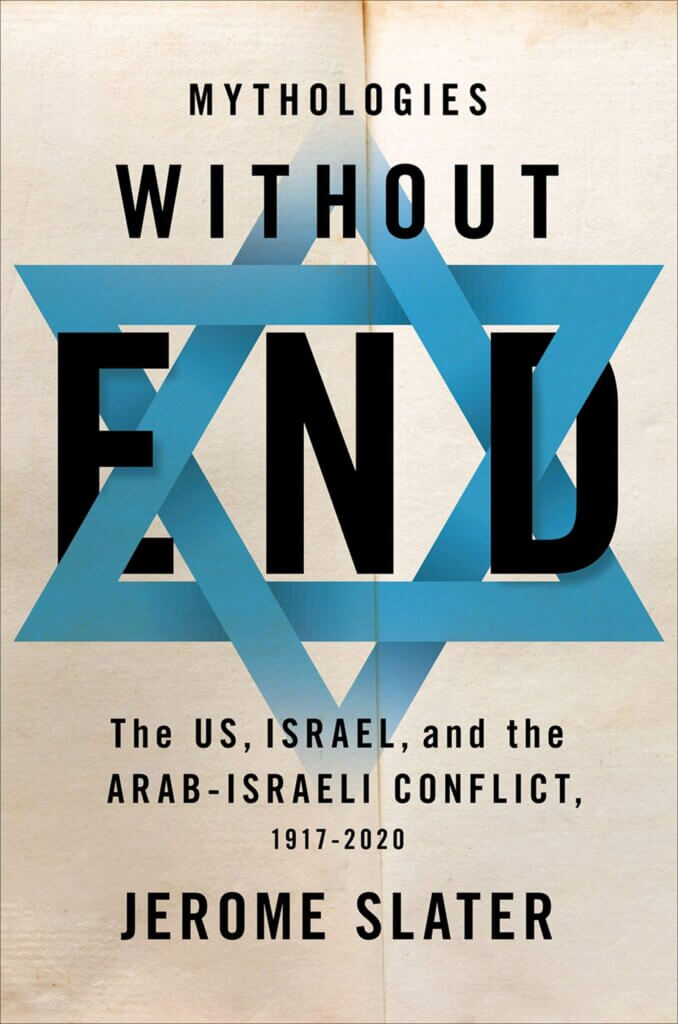MYTHOLOGIES WITHOUT END
The U.S., Israel, and the Arab-Israeli Conflict
By Jerome Slater
495 pp. Oxford University Press. $29.95
Professor Jerry Slater is 85 years old, has taught truths about Israel and Palestine for 50 years, and set himself a monumental task in this book. He does not just cover the Israel-Palestine conflict, but takes on myths about Israel’s relations with the surrounding Arab states, and the role of the United States. The result is a masterpiece, the successful work of a lifetime.
Slater presents his own personal and intellectual odyssey, in a brief but compelling Prologue:
Like almost all Jews of my generation, coming of age in America in the 1940s, immediately after the Holocaust and with Anti-Semitism still alive in this country I thought of myself as a passionate Zionist and rejoiced over the establishment of the state of Israel and its 1948 and 1967 victories over its Arab enemies.
He started changing his mind after the 1967 Six-Day War. And now he has made an extraordinary contribution to the global movement for justice in Israel, Palestine, and the Mideast generally, a readable and encyclopedic work that will be invaluable for years to come.

Slater chose the perfect title, “Mythologies Without End.” First he outlines the received wisdom about an element or feature of the region’s history. Then he coolly looks at the record, and punctures the myths. He points out:
. . . among both Israelis and Americans there has been no other conflict that has been so badly understood, so impervious to the ever-growing and overwhelming historical evidence, and in which the mythology has had such devastating consequences.
Nothing is too farfetched for Slater to calmly examine. He even goes back 2000 years, to start with the prevalent Israeli “Myth of Original Homeland, Exile and Expulsion.” He notes that after the Jewish rebellion against Rome in 66-70 CE, “Zionist mythology holds that ‘the Romans may have laid the entire nation waste between AD 70 and 135, slaughtering as many as 600,000 Jews, and carrying off half that number in bondage.’” He notes dryly, “This myth is no longer taken seriously by informed historians,” and clearly provides the evidence that refutes the claim.
Then, 1948. The story goes that a fragile Israel declared independence — and then the four neighboring Arab states invaded. Slater writes: “In the Israeli mythology, the Arab attack was huge, closely coordinated, and because it was motivated by pure anti-Semitism, there was no chance the war could have been avoided.” Once again, he looks meticulously at the actual record, and relying on, among others, Israel’s New Historians, points out that “the Arab invasion was small, uncoordinated, riven with conflicting aims, and in all probability could have been avoided if the Israeli leaders were willing to negotiate fair compromises.”

Even those of us with familiarity with the myths may be surprised at some of Slater’s findings. It turns out that the “every major Zionist leader” from Theodore Herzl onward openly supported “transfer” — a euphemism for expelling the original Palestinian Arab inhabitants. In short, the Nakba, when 700,000 Palestinians fled or were driven away during the 1948 war and were not allowed to return, was not partly the accidental by-product of the conflict, but had been the intention all along of David Ben-Gurion and Israel’s other founders.
This exhaustive debunking of historical myths continues. Slater covers it all: the 1956 British/French/Israel invasion of Egypt to seize the Suez Canal; the Six-Day War in 1967; the 1973 Israeli-Egyptian War. At every stage, he shows that the world has been given distorted versions of the events or outright falsehoods.
His account is particularly important when he reaches the 1993 Oslo Accords and developments since then, because he presents what is probably so far the most comprehensive account of this recent period. He warns that the Accords were not truly a breakthrough for peace, that in fact they “did more to preserve the Israeli occupation [of Palestine] than to end it.” He explains that Israel’s leaders undermined the weak agreement right from the start, partly because they knew Israeli voters would punish them otherwise. And the number of Israeli “settlers” continued to jump:
At the outset of the Clinton presidency, there were 3,000 Israeli settlers in Gaza and 117,000 in the West Bank; when he left office at the end of 2000 there were 6,700 settlers in Gaza and 200,000 in the West Bank.
Then, Slater analyzes the 2000 Camp David talks, hosted by Bill Clinton. He presents the myth: Israeli Prime Minister Ehud Barak offered Yasser Arafat and the Palestine Liberation Organization a generous peace agreement, but the Palestinians “. . . refused to make compromises of their own, made no counteroffers to the Israeli proposals, and then launched a new violent and often terrorist intifada, demonstrating that they had no interest in peace but rather still sought to destroy Israel and take over all of historic Palestine.” Slater responds, “As with the many other mythologies in the Arab-Israeli conflict, this bears little resemblance to reality. . .”
That false explanation for the failure at Camp David was only another instance of a central dishonesty over many decades: the Israeli/Zionist claim that “the Arabs” will not negotiate, a false view captured in the famous 1973 statement by the Israeli foreign minister, Abba Eban: “The Arabs never miss an opportunity to miss an opportunity.”
Such a view does not survive Jerry Slater’s wrecking ball:
The historical record proves that this myth has it backward: it is Israel, far more than its Arab adversaries, that has been primarily responsible for the many lost opportunities, from 1947 through the present, to end the Arab-Israeli and Israeli-Palestinian conflicts. At one time or another, all the important Arab states and the most important Palestinian leaders — including Yasser Arafat — have been ready to agree to attainable and fair compromise settlements of all the central issues: Israeli security, its legitimate territory and borders, the creation of a Palestinian state, the status of Jerusalem, and the Palestinian refugee issue.
In lesser hands, this 495-page debunking might have bogged down, but Jerry Slater is such a skilled wordsmith that your interest does not flag. Instead, the cumulative power of his de-mythologizing increases as the book moves smartly along.
Slater has moral and intellectual courage, rigorous research standards — and a clear writing style that keeps you engaged with this long, thorough book.
He brings “Mythologies Without End” completely up to date, with a sharp look at how Benjamin Netanyahu has no interest in an agreement with the Palestinians and with a refutation of the 2020 Trump “peace plan.” But he points out that Israel’s occupation of Palestine has marched on, and that Netanyahu couldn’t settle with the Palestinians even if he wanted to. He says that if Netanyahu
had been willing to order a withdrawal of the settlers and military forces from the occupied territories and agree to a viable Palestinian state, with sovereignty over East Jerusalem, he would have faced a revolt, quite possibly a violent revolt, from the settlers and their supporters. Indeed, a number of Israeli analysts feared that even the armed forces, in which settlers and right-wing religious forces were becoming increasingly strong, would refuse to obey such orders.
You won’t read anything that brutally realistic and honest in the mainstream U.S. press — or in funding appeals from liberal Zionist organizations.
You finish this long work with a tremendous sense of admiration for its author, and for his successful life’s work. Let us give him the last word. Here’s the book’s final sentence:
If there is ever to be an at least minimally just solution to the Israeli-Palestinian conflict, whether it takes the form of some kind of two-state settlement or a binational democratic single state, the most important prerequisite, indeed the sine qua non, must be an Israeli recognition that their historical narrative of the conflict is largely mythological and that they have incurred an overwhelming moral obligation and an enlightened national self-interest to reach a peace settlement with the Palestinian people.



Thank you Mondoweiss and major kudos to Jerome Slater for his just published book documenting the ugly truth of Zionism and its spawn, the racist, fascistic, expansionist, borderless, U.S. dependent entity referred to as “Israel.” I look forward to reading it.
“Israel” is also rotting within:
https://www.timesofisrael.com/startup-nation-sees-brain-drain-as-national-priorities-sidelined/
“Losing our best minds: Startup Nation sees brain drain, fall in productivity”
“For every graduate who returns to Israel, 4.5 emigrate; ‘exceptionally small’ number of people responsible for propelling the economy, report says; also warns of growing inequality” Times of Israel, By SHOSHANNA SOLOMON , June 5, 2019
I just got my copy of Slater’s book and while I look forward to reading it, it’s clearly a heavy duty project. For anyone looking for a book that debunks the myths but can be read in a weekend, try Peter Beinart’s “The Crisis of Zionism. From page 120:
In fact, Netanyahu had a clear vision of where he hoped Oslo would lead. Over the course of the 1990s, he detailed his vision in books and op-eds; he drew maps on napkins; he even presented a plan to his cabinet. Under Netanyahu’s plan, the Palestinians would live in four disconnected cantons: one encompassing Jenin, Nablus and Ramallah in the north; a second comprising Bethlehem and Hebron in the south; a third encompassing Jericho in the east; and a fourth encompassing Qalqilya in the west. Together, these cantons would comprise roughly 40 percent of the West Bank, Israel would control the other 60 percent….. These four Palestinian cantons would not constitute a state – indeed, even they would be bisected by Israeli roads…Netanyahu’s vision left Americans dumbfounded….
A relatively small bunch of religious fanatics (about 430,000 “settlers”) does not have the power to drag the US government around by the nose, and neither, it seems to me, do they likely have the power to drag the Israeli government around by the nose. In both cases, it seems to me, the real power is most probably the financial power behind the “settlers”. I’d look at the financial power that financed that 1948 invading Zionist army about which Slater writes.